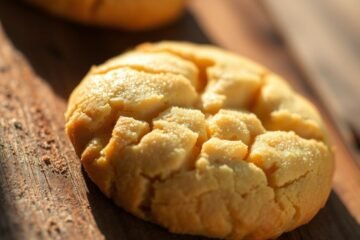Tanghulu : Authentic Chinese Candied Fruit Skewers
Imagine strolling through a bustling street market, the air filled with the sweet scent of caramelized sugar and the vibrant colors of fresh fruit. This is the world of Tanghulu, a traditional snack that has captured the hearts of many around the globe.

Tanghulu, or Chinese Candied Fruit Skewers, is more than just a tasty treat; it’s a cultural icon that brings people together. With its origins deeply rooted in Chinese tradition, Tanghulu has evolved into a beloved snack worldwide, enjoyed by people of all ages.
As we delve into the world of Tanghulu, we’ll explore its history, cultural significance, and the unique experience it offers. Whether you’re a food enthusiast or just curious about new flavors, Tanghulu is sure to captivate your senses and leave you wanting more.
The Sweet History of Tanghulu in Chinese Culture
With a history dating back to the Song Dynasty, Tanghulu has evolved into a cultural icon of traditional Chinese street food, symbolizing the country’s rich culinary heritage. This sweet fruit skewer has been a staple in Chinese culture, enjoyed during various festivals and celebrations.
Tanghulu’s origins are rooted in the ancient tradition of candying fruits to preserve them. Over time, this practice transformed into a popular street snack, with vendors selling candied fruit skewers to the masses. The process of making Tanghulu was not only a way to enjoy seasonal fruits year-round but also an art form, requiring skill and patience to achieve the perfect balance of sweetness and crunch.
As traditional Chinese street food, Tanghulu has played a significant role in Chinese festivals and celebrations. During the Winter Solstice, for example, Tanghulu is a must-have snack, symbolizing the reunion of family and friends. The snack’s popularity has endured through the centuries, with its appeal lying in its simplicity, flavor, and the nostalgia it evokes.
In modern times, Tanghulu continues to be a beloved sweet fruit skewer, with its traditional recipe being passed down through generations. The snack has also undergone various innovations, with new flavors and ingredients being introduced to cater to changing tastes.
What is Tanghulu (Chinese Candied Fruit Skewers)?
The traditional Chinese treat known as Tanghulu involves skewering fruit and coating it in a layer of crystallized sugar, creating a delightful snack known as sugar-coated fruit sticks.
Tanghulu is made by selecting fresh fruit, typically hawthorn berries, strawberries, or grapes, and threading them onto bamboo skewers. The fruit is then dipped into a hot sugar syrup, which caramelizes upon cooling, forming a crunchy, sweet coating around the fruit.

The process of making Tanghulu is both an art and a science. The sugar syrup must be heated to the right temperature to achieve the perfect crystallization. If the syrup is too hot, it can burn the sugar; if it’s too cold, it won’t coat the fruit properly. This traditional method results in a deliciously crunchy exterior giving way to fresh, juicy fruit inside, embodying the essence of sugar-coated fruit sticks.
Various types of fruit can be used to make Tanghulu, including seasonal fruits to ensure freshness and flavor. The most common fruits used are hawthorn berries, which are traditional, and more modern choices like strawberries and grapes. The versatility in fruit selection allows Tanghulu vendors to innovate while staying true to their roots, creating a range of sugar-coated fruit sticks that cater to different tastes.
In summary, Tanghulu, or Chinese Candied Fruit Skewers, is a traditional snack that combines the natural sweetness of fruit with a sugary coating, creating a treat that is both familiar and exciting. Whether enjoyed on the streets of China or at home, Tanghulu remains a beloved snack, cherished for its simplicity and flavor, making it a quintessential example of sugar-coated fruit sticks.
The Art of Making Traditional Tanghulu
Crafting traditional Tanghulu is an art that requires precision, patience, and a deep understanding of the candy-making process. This ancient Chinese treat has been delighting people for centuries, and with the right guidance, you can create it in your own kitchen.
The first step in making Tanghulu is achieving the ideal temperature for the sugar syrup. Heating the syrup to the correct temperature is crucial for creating a smooth, glossy coating on the fruit.
Achieving the Ideal Temperature
To make the perfect sugar syrup, combine granulated sugar and water in a saucepan and heat it over medium heat, stirring until the sugar dissolves. Monitor the temperature closely, as it needs to reach the hard-crack stage.
Testing for the Hard-Crack Stage
The hard-crack stage is reached when the syrup reaches 300°F (149°C). To test for this stage, drop a small amount of the syrup into cold water; if it forms a hard, brittle thread that cracks when bent, it’s ready.
Hawthorn berries are the traditional fruit used for Tanghulu. To prepare them, wash and dry the berries, then thread them onto skewers. Dip the skewers into the hot sugar syrup, coating the berries evenly.
Alternative Fruit Options
While hawthorn is traditional, you can also use other fruits like strawberries, grapes, or pineapple chunks. The key is to choose fruits that are firm enough to hold their shape when coated in the syrup.
By following these steps and practicing your technique, you’ll be well on your way to creating delicious, authentic Tanghulu at home. Experiment with different fruits and flavor combinations to make the treat your own.
Regional Variations of Tanghulu Across China
The diversity of Tanghulu is showcased through its regional variations across China, reflecting local tastes and ingredients. Tanghulu, a traditional Chinese candied fruit skewer, has been a beloved snack for centuries, with its preparation and ingredients evolving differently in various regions.
In Northern China, Tanghulu is often made with crunchy, sweet, and slightly salty ingredients, reflecting the region’s preference for robust flavors. In contrast, Southern China prefers a sweeter and softer version, often using tropical fruits like lychees and pineapples.
The regional variations of Tanghulu are not just about the ingredients; the preparation methods also differ. For instance, some regions coat the fruit in a syrup made from cane sugar, while others use honey or malt sugar for a different flavor profile.
These variations highlight the adaptability of Tanghulu to local tastes and ingredients, making it a unique snack in different parts of China. Whether it’s the north or the south, Tanghulu remains a cherished treat, symbolizing the rich culinary diversity of China.
Exploring these tanghulu variations offers a glimpse into China’s diverse culinary landscape, where a simple snack can have numerous interpretations based on regional preferences.
Modern Tanghulu Innovations and Global Popularity
As a popular Chinese dessert, Tanghulu is being reimagined for a global audience. Its traditional recipe has been a staple in Chinese culture, but modern innovations have taken it to new heights.
The classic sugar-coated fruit skewers have evolved with new flavors and ingredients. Modern vendors are experimenting with unique combinations, such as matcha, strawberry, and even chocolate-coated Tanghulu. These innovations have made it a hit on social media platforms, where visually appealing and Instagrammable food is king.
The global popularity of Tanghulu can be attributed to its versatility and appeal. It’s no longer just a traditional snack; it’s a dessert that’s being incorporated into modern cuisine. Restaurants and food bloggers are putting their own spin on it, making it a staple in international cuisine.
Tanghulu’s presence on social media has also contributed to its global popularity. The visually appealing dessert is being shared and admired by food enthusiasts worldwide. As a result, Tanghulu has become a popular Chinese dessert globally, with its traditional essence intact.
The future of Tanghulu looks bright, with its modern innovations and global popularity showing no signs of slowing down. As it continues to evolve, it will be exciting to see how this traditional Chinese dessert continues to captivate audiences worldwide.
The Street Food Experience: Tanghulu Vendors in China
Strolling through the bustling streets of China, the sweet aroma of Tanghulu wafts through the air, beckoning passersby to indulge in this traditional candied fruit snack. Tanghulu vendors are an integral part of the street food landscape, offering a delightful experience that combines taste, tradition, and atmosphere.
The atmosphere around Tanghulu vendors is lively and inviting. As night falls, the vendors’ stalls are illuminated, casting a warm glow over the colorful displays of candied fruits. The sizzle of sugar caramelizing on the fruit skewers adds to the sensory experience, making it irresistible to locals and tourists alike.
Tanghulu vendors offer a variety of flavors, from traditional hawthorn berries to more modern options like strawberries and grapes. This diversity caters to a wide range of tastes, ensuring that there’s something for everyone. The vendors’ ability to innovate while staying true to traditional methods is a testament to the enduring appeal of Tanghulu.
The cultural significance of Tanghulu vendors extends beyond just the food; they represent a connection to China’s rich culinary heritage. Enjoying Tanghulu from a street vendor is not just about satisfying a sweet tooth; it’s an experience that encapsulates the sights, sounds, and flavors of Chinese culture.
- Vibrant street food culture
- Diverse flavors and options
- Rich cultural heritage
Where to Find Authentic Tanghulu in the United States
The quest for authentic Tanghulu in the U.S. leads to a variety of Chinese eateries and online platforms. For those eager to indulge in this traditional Chinese snack, several options are available across the country.
Chinese Restaurants and Street Food Festivals are among the top places to experience authentic Tanghulu. Many Chinese restaurants, especially those that specialize in traditional or regional Chinese cuisine, offer Tanghulu as a dessert or snack. Street food festivals, particularly those celebrating Asian cultures, are also hotspots for Tanghulu vendors.
When searching for Tanghulu, it’s essential to look for certain characteristics to ensure authenticity. Fresh fruit and a glossy sugar coating are indicators of well-made Tanghulu. The fruit should be skewered on bamboo sticks, and the sugar syrup should be hardened to a candy-like consistency.
Here are some tips for finding authentic Tanghulu:
- Look for vendors or restaurants that specialize in traditional Chinese cuisine.
- Check the ingredients and preparation methods to ensure they align with traditional Tanghulu making.
- Be wary of overly commercialized or modified versions that may stray from the authentic recipe.
Online stores and Asian grocery stores are also viable options for those looking to purchase Tanghulu or make it at home. Many online platforms offer pre-made Tanghulu or the necessary ingredients and kits to create it.
By knowing where to look and what to look for, fans of Tanghulu can enjoy this delightful Chinese snack in the comfort of their own homes or at various culinary events across the U.S.
Homemade Tanghulu Recipe: Complete Guide
Tanghulu, or Chinese candied fruit skewers, is a classic street food that you can easily make at home with just a few simple ingredients and some basic cooking skills.
Fruit Selection and Preparation Tips
Choosing the right fruit is crucial for making great Tanghulu. Opt for fresh, firm fruits like strawberries, grapes, or hawthorn berries. Wash and dry them thoroughly before threading them onto skewers.
Sugar Syrup Components
The sugar syrup is the heart of Tanghulu, made from granulated sugar and water. Some recipes may include additional ingredients like maltose or corn syrup to enhance the texture and flavor.
Creating the Perfect Sugar Syrup
To create the perfect sugar syrup, combine sugar and water in a saucepan and heat it until the sugar dissolves. Bring the mixture to a boil, then reduce the heat to maintain a simmer. The syrup is ready when it reaches the hard-ball stage, around 300°F.
Once your syrup is ready, dipping the fruit skewers should be done quickly to coat them evenly. After dipping, place the skewers on a parchment-lined surface or a lightly oiled plate to cool and harden.
Storage and Serving Suggestions
Tanghulu is best consumed fresh, but you can store it in an airtight container for a few hours. Avoid refrigerating as it can cause the sugar coating to become sticky.
Fixing Cloudy or Soft Coating
If your Tanghulu has a cloudy or soft coating, it might be due to improper syrup temperature or humidity. Adjusting the syrup temperature or working in a drier environment can help.
Preventing Crystallization
Crystallization can occur if the syrup is not cooled properly or if it’s seeded with sugar crystals. Avoid stirring the syrup excessively and ensure it’s cooled slowly to prevent this issue.
Conclusion: Embracing the Sweet Tradition of Tanghulu
Tanghulu, a traditional Chinese street food, has been a beloved treat for centuries. Its sweet and crunchy exterior giving way to a juicy, fruity center has captured the hearts of many. As we’ve explored, Tanghulu is more than just a snack – it’s a cultural phenomenon that brings people together.
From its rich history to its modern innovations, Tanghulu has evolved while remaining true to its roots. Whether enjoyed on the streets of China or made at home, Tanghulu is a delicious way to experience the country’s vibrant culture. As its global popularity continues to grow, it’s clear that Tanghulu is here to stay.
By embracing the sweet tradition of Tanghulu, we can appreciate the simple joys of this traditional Chinese street food. So, the next time you’re looking for a sweet treat, consider giving Tanghulu a try – you might just discover a new favorite snack.
FAQ
What is Tanghulu?
Tanghulu is a traditional Chinese snack consisting of candied fruit skewers, typically made with fresh fruit coated in a sugar syrup.
What type of fruit is used to make Tanghulu?
Common fruits used to make Tanghulu include hawthorn, strawberries, grapes, and pineapple, although various regional and personal preferences may vary.
How is the sugar syrup for Tanghulu prepared?
The sugar syrup is prepared by heating sugar to a specific temperature, typically the hard-crack stage, to achieve the desired consistency and texture for coating the fruit.
Can I make Tanghulu at home?
Yes, making Tanghulu at home is possible with the right ingredients and equipment, and by following a simple recipe and guidelines for achieving the perfect sugar syrup.
What are some common issues when making Tanghulu, and how can I troubleshoot them?
Common issues include a cloudy or soft coating, which can be resolved by adjusting the sugar syrup temperature or ratio of sugar to water, and preventing crystallization by avoiding introducing nucleation sites.
Where can I find authentic Tanghulu in the United States?
Authentic Tanghulu can be found in Chinese restaurants, street food festivals, and online stores that specialize in traditional Chinese snacks and desserts.
Are there any variations of Tanghulu across different regions in China?
Yes, different regions in China have their unique variations of Tanghulu, incorporating local fruits, ingredients, and preparation methods that reflect the diversity of Chinese cuisine.
Is Tanghulu a popular dessert globally?
Tanghulu has gained popularity worldwide, not only for its unique taste but also for its cultural significance and visually appealing presentation, making it a sought-after dessert in international cuisine.



0 Comments